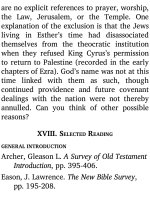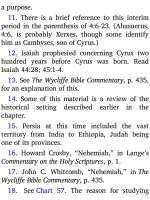Jensens survey of the old testament adam 249
Bạn đang xem bản rút gọn của tài liệu. Xem và tải ngay bản đầy đủ của tài liệu tại đây (84.54 KB, 4 trang )
1. Date written. If Joel lived during the
reign of Joash, he was one of the earliest
writing prophets. The book, then, was
written around 820 B.C. (Chart 104). Some
Bible students prefer the view that Joel lived
after the Babylonian Exile (586 B.C.).9 This
manual follows the view of the early date.
2. Setting.
a) Political and religious. Joash10 was king
of Judah when Joel ministered as the
nation’s prophet. He began his forty-year
reign when he was only seven years old, and
his guardian-instructor in the early years
was the godly high priest Jehoiada.11 Up
until Jehoiada’s death, Joash’s reign was
mainly a righteous one (2 Kings 12:2). When
Jehoiada died, Joash defected to idolatrous
ways, even slaying Jehoiada’s godly son
(read 2 Chron 24:15-25). Joel probably
wrote his book while Joash was still a minor
under Jehoiada’s tutelage. This may partly
account for the absence in Joel of long
descriptions of national sin, usually found in
the messages of the prophets.
During Joash’s reign Judah was not free
from the threat of invasion by foreigners.
Read 2 Kings 12:17-19 and 2 Chronicles 24:
23-25, which describe the Syrian invasion
toward the end of Joash’s life.
b) Economic. Severe plagues of locusts and
drought had recently devastated the land of
Judah when Joel penned his prophecy. In
the opening lines of the book he asks the
elders, “Has anything like this happened in
your days or in your fathers’ days?” (1:2).
He is referring to the locust plagues,
described in the next verse:
What the gnawing locust has left, the
swarming locust has eaten;
And what the swarming locust has left,
the creeping locust has eaten;
And what the creeping locust has left,
the stripping locust has eaten (1:3).
Only those who have witnessed a locust
plague can fully appreciate why it is so
dreaded. Joel could not have used a better
symbol than this to pre gure the coming
“terrible day of the LORD.”
3. Style. The smooth and vivid style of
Joel has contributed to his book being called
one of the literary gems of the Old
Testament.
4. Purposes. Three main purposes of Joel’s
prophecy are (1) to foretell coming
judgments upon Judah for their sin; (2) to
exhort Judah to turn their hearts to the
Lord; and (3) to impress upon all people that
this world’s history will culminate in the
events of the Day of the Lord, when the
scales of justice will finally rest.
5. The Day of the Lord. Five times in Joel
the phrase “the day of the LORD” appears.
Joel uses the phrase to refer to end times.
Even when the New Testament writers
referred to that day, it was still future. For
example, read 2 Thessalonians 2:2 and 2
Peter 3:10. In the Old Testament the phrase
occurs over thirty times, in such verses as
Isaiah 2:12; 13:6, 9; Joel 1:15; Amos 5:18;
Ezekiel 13:5; 30:3; Zephaniah 1:7, 14. Read
these
passages,
observing
that
the
descriptions of this “day” are usually about
judgment and war against sinners, a
necessary purge before righteousness can
reign. Saints are involved in this day in the
sense that when the Lord brings judgment
upon unbelievers, the saints are associated
with their Lord in the victory. (For example,
the Millennium, issuing out of the Battle of
Armageddon, may be considered a part of
this “day of the LORD.” In this connection it









